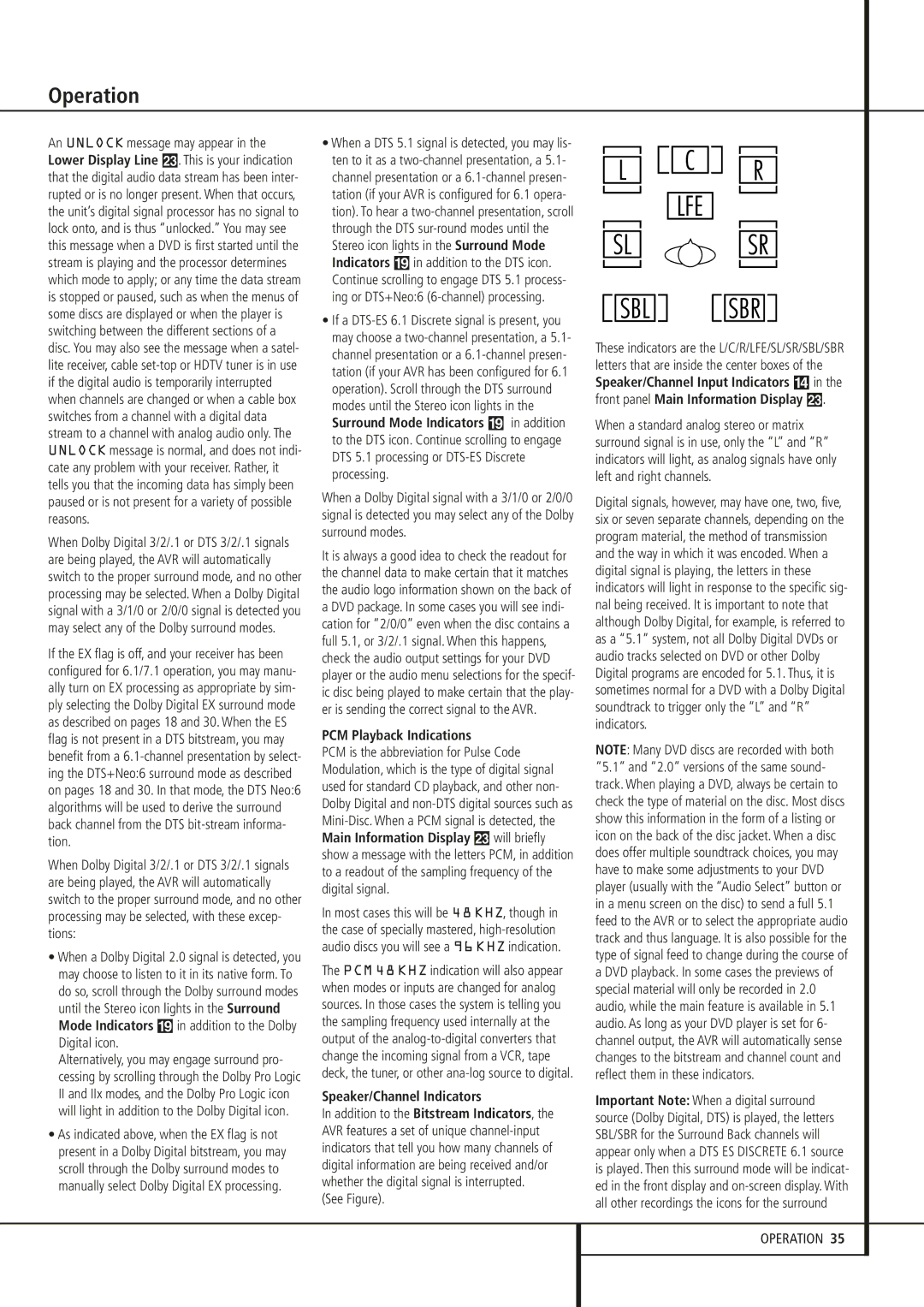
Operation
An UNLOCK message may appear in the Lower Display Line Ò. This is your indication that the digital audio data stream has been inter- rupted or is no longer present. When that occurs, the unit’s digital signal processor has no signal to lock onto, and is thus “unlocked.” You may see this message when a DVD is first started until the stream is playing and the processor determines which mode to apply; or any time the data stream is stopped or paused, such as when the menus of some discs are displayed or when the player is switching between the different sections of a disc. You may also see the message when a satel- lite receiver, cable
When Dolby Digital 3/2/.1 or DTS 3/2/.1 signals are being played, the AVR will automatically switch to the proper surround mode, and no other processing may be selected. When a Dolby Digital signal with a 3/1/0 or 2/0/0 signal is detected you may select any of the Dolby surround modes.
If the EX flag is off, and your receiver has been configured for 6.1/7.1 operation, you may manu- ally turn on EX processing as appropriate by sim- ply selecting the Dolby Digital EX surround mode as described on pages 18 and 30. When the ES flag is not present in a DTS bitstream, you may benefit from a
When Dolby Digital 3/2/.1 or DTS 3/2/.1 signals are being played, the AVR will automatically switch to the proper surround mode, and no other processing may be selected, with these excep- tions:
•When a Dolby Digital 2.0 signal is detected, you may choose to listen to it in its native form. To do so, scroll through the Dolby surround modes until the Stereo icon lights in the Surround Mode Indicators ( in addition to the Dolby Digital icon.
Alternatively, you may engage surround pro- cessing by scrolling through the Dolby Pro Logic II and IIx modes, and the Dolby Pro Logic icon will light in addition to the Dolby Digital icon.
•As indicated above, when the EX flag is not present in a Dolby Digital bitstream, you may scroll through the Dolby surround modes to manually select Dolby Digital EX processing.
•When a DTS 5.1 signal is detected, you may lis- ten to it as a
•If a
When a Dolby Digital signal with a 3/1/0 or 2/0/0 signal is detected you may select any of the Dolby surround modes.
It is always a good idea to check the readout for the channel data to make certain that it matches the audio logo information shown on the back of a DVD package. In some cases you will see indi- cation for “2/0/0” even when the disc contains a full 5.1, or 3/2/.1 signal. When this happens, check the audio output settings for your DVD player or the audio menu selections for the specif- ic disc being played to make certain that the play- er is sending the correct signal to the AVR.
PCM Playback Indications
PCM is the abbreviation for Pulse Code Modulation, which is the type of digital signal used for standard CD playback, and other non- Dolby Digital and
In most cases this will be 48 KHZ, though in the case of specially mastered,
The PCM 48 KHZ indication will also appear when modes or inputs are changed for analog sources. In those cases the system is telling you the sampling frequency used internally at the output of the
Speaker/Channel Indicators
In addition to the Bitstream Indicators, the AVR features a set of unique
(See Figure).
These indicators are the L/C/R/LFE/SL/SR/SBL/SBR letters that are inside the center boxes of the Speaker/Channel Input Indicators $ in the front panel Main Information Display Ò.
When a standard analog stereo or matrix surround signal is in use, only the “L” and “R” indicators will light, as analog signals have only left and right channels.
Digital signals, however, may have one, two, five, six or seven separate channels, depending on the program material, the method of transmission and the way in which it was encoded. When a digital signal is playing, the letters in these indicators will light in response to the specific sig- nal being received. It is important to note that although Dolby Digital, for example, is referred to as a “5.1” system, not all Dolby Digital DVDs or audio tracks selected on DVD or other Dolby Digital programs are encoded for 5.1. Thus, it is sometimes normal for a DVD with a Dolby Digital soundtrack to trigger only the “L” and “R” indicators.
NOTE: Many DVD discs are recorded with both “5.1” and “2.0” versions of the same sound- track. When playing a DVD, always be certain to check the type of material on the disc. Most discs show this information in the form of a listing or icon on the back of the disc jacket. When a disc does offer multiple soundtrack choices, you may have to make some adjustments to your DVD player (usually with the “Audio Select” button or in a menu screen on the disc) to send a full 5.1 feed to the AVR or to select the appropriate audio track and thus language. It is also possible for the type of signal feed to change during the course of a DVD playback. In some cases the previews of special material will only be recorded in 2.0 audio, while the main feature is available in 5.1 audio. As long as your DVD player is set for 6- channel output, the AVR will automatically sense changes to the bitstream and channel count and reflect them in these indicators.
Important Note: When a digital surround source (Dolby Digital, DTS) is played, the letters SBL/SBR for the Surround Back channels will appear only when a DTS ES DISCRETE 6.1 source is played. Then this surround mode will be indicat- ed in the front display and
OPERATION 35
